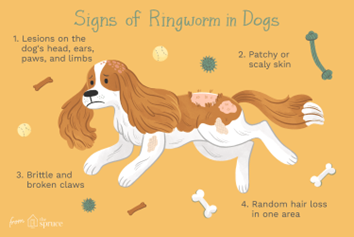Ringworm in dogs
What is Ringworm?
Ringworm is a skin condition which is frequently brought on by fungi. These fungi are caused by dermatophytes’ invasion of keratinized epithelial cells and hair fibres, which affects superficial keratinized tissue such as hair, nail, and skin in both humans and animals1.
It is also a zoonotic condition, which means that it can spread from pets to people1.
Ringworm’s most distinctive characteristic is alopecia (hair loss) with or without crust formation, in circular scaly areas1.
How is Ringworm spread?
Ringworm is contagious, and transmission takes place by having direct contact with the fungus. It is spread by direct contact with an infectious person or animal, as well as the handling or touching of infected objects or surfaces1.
How does my dog get in contact with the fungus?
- Spending a lot of time outdoors2.
- Digging2.
It can also be spread from external surfaces such as combs, brushes, food dishes, furniture, bedding, and carpet, as the fungal spores may remain inactive for numerous months (up to 18 months). Note that an infection does not always result from contact with the ringworm fungus1.
How do I treat it?
The primary purpose of the treatment is to reduce the spread to other animals and humans1.
Environmental control
Before anything, you should isolate the diseased dog and contaminate everything they used or touched1
Topical treatment
In mild cases, topical therapy may be sufficient to speed up healing and minimise the risk of the disease spreading to other animals or individuals. Shaving long coats can help topical medicines penetrate the skin1.
Systemic treatment
An oral anti-fungal medication is needed for successful treatment1
References
- Hesham, A. and Atwa, S. (2021) Ringworm in dogs, Semantic scholar. Available at: https://www.semanticscholar.org/paper/Ringworm-in-dogs-Hesham-Atwa/d29bc7a7715539220c1d9d8425f10e360a712939 (Accessed: December 7, 2022).
- STREGOWSKI, J.E.N.N.A. (2022) “Ringworm in Dogs Causes, Treatment, and Prevention,” The Spruce Pets, 4 May. Available at: https://www.thesprucepets.com/what-is-ringworm-3384816 (Accessed: December 7, 2022).

